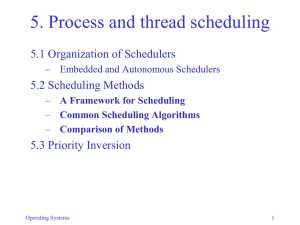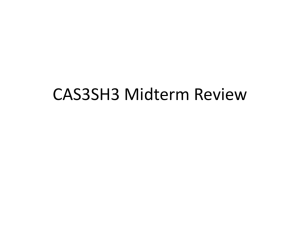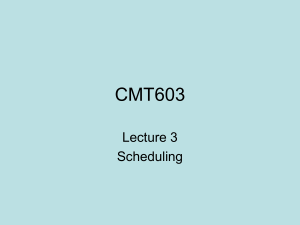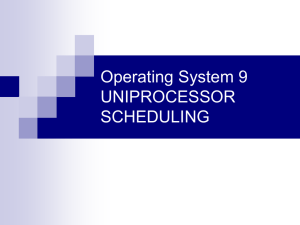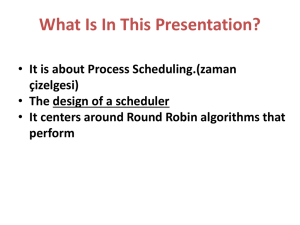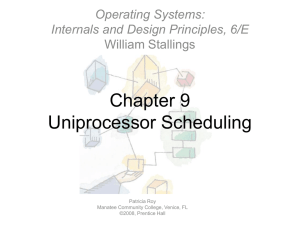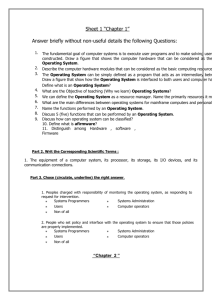Chapter06
advertisement
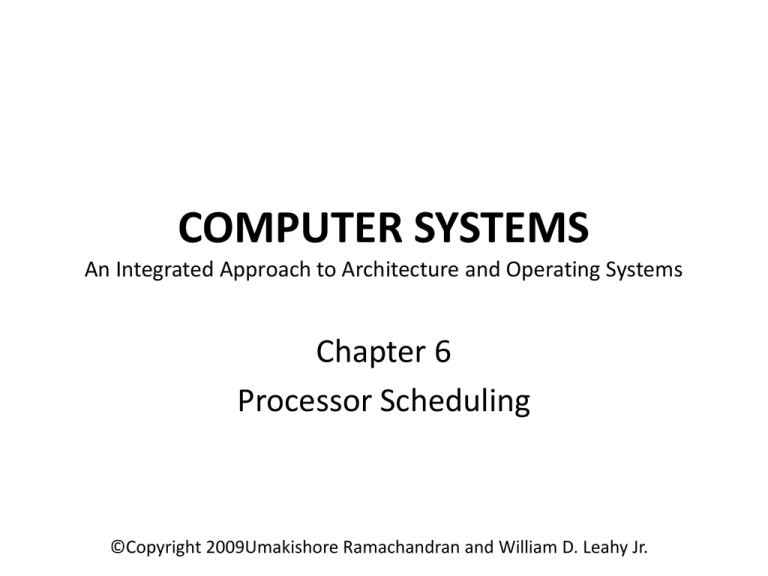
COMPUTER SYSTEMS
An Integrated Approach to Architecture and Operating Systems
Chapter 6
Processor Scheduling
©Copyright 2009Umakishore Ramachandran and William D. Leahy Jr.
6.1 Introduction
• Things to Do
– Laundry
– Study for Test
– Cook and eat dinner
– Call Mom for her birthday
• How would you do it?
6.2 Programs and Processes
• What is an operating system?
• What are resources?
• How do we create programs?
6.2 Programs and Processes
• What is the memory footprint
of a user program?
Low memory
Use by the OS
Program code
Program global data
Program heap
Memory footprint
of
User program
Program stack
High memory
Use by the OS
Program 1
Program 2
.
.
• What is the overall view of
memory?
• Why?
.
Program
n
OS Data
Structures
OS routines
6.2 Programs and Processes
• What resources are required to run:
Hello, World!
• What is a scheduler?
Program Properties
Expected running time
Expected memory usage
Expected I/O requirements
Process/System Properies
Available system memory
Arrival time of a program
Instantaneous memory requirements
Process 1
Process 2
.
.
.
Process n
Processor
scheduler
winner
6.2 Programs and Processes
Program
• On disk
• Static
• No state
– No PC
– No register usage
• Fixed size
One program may
yield many processes
Process
• In memory (and disk)
• Dynamic – changing
• State
– PC
– Registers
• May grow or shrink
• Fundamental unit of
scheduling
6.2 Programs and Processes
Name
Job
Process
Usual Connotation
Unit of scheduling
Program in
execution; unit of
scheduling
Use in this chapter
Synonymous with process
Synonymous with job
Thread
Unit of scheduling
and/or execution;
contained within a
process
Not used in the scheduling algorithms
described in this chapter
Task
Unit of work; unit of Not used in the scheduling algorithms
scheduling
described in this chapter, except in
describing the scheduling algorithm of
Linux
6.3 Scheduling Environments
6.3 Scheduling Environments
Name
Long term scheduler
Environment
Batch oriented OS
Loader
In every OS
Medium term scheduler
Every modern OS (timeshared, interactive)
Short term scheduler
Every modern OS (timeshared, interactive)
Dispatcher
In every OS
Role
Control the job mix in
memory to balance use of
system resources (CPU,
memory, I/O)
Load user program from
disk into memory
Balance the mix of
processes in memory to
avoid thrashing
Schedule the memory
resident processes on the
CPU
Populate the CPU registers
with the state of the process
selected for running by the
short-term scheduler
6.3 Scheduling Environments
Process States
New
Admitted
Exit
Halted
Interrupt
Ready
Running
Scheduler Dispatch
I/O or Event Completion
Waiting
I/O or Event Wait
6.4 Scheduling Basics
6.4 Scheduling Basics
• Schedulers come in two basic flavors
– Preemptive
– Non-preemptive
• Basic scheduler steps
1.
2.
3.
4.
Grab the attention of the processor.
Save the state of the currently running process.
Select a new process to run.
Dispatch the newly selected process to run on
the processor.
6.4 Scheduling Basics
• What information is important to know about
a process?
6.4 Scheduling Basics
• Process Control Block
enum
state_type {new, ready, running, waiting, halted};
typedef struct control_block_type {
struct control_block *next_pcb; /*
enum state_type state;
/*
address PC;
/*
int reg_file[NUMREGS];
/*
int priority;
address address_space;
…
…
} control_block;
list ptr */
current state */
where to resume */
contents of GPRs */
/* extrinsic property */
/* where in memory */
next_pcb
info…
6.4 Scheduling Basics
Partially Executed
Swapped Out Processes
Ready Queue
I/O
I/O Queue
CPU
I/O Request
Time Slice Expired
Child Executes
Fork a Child
Interrupt Occurs
Wait for an
Interrupt
6.4 Scheduling Basics
Name
CPU burst
I/O burst
PCB
Ready queue
I/O queue
Non-Preemptive
algorithm
Preemptive
algorithm
Thrashing
Description
Continuous CPU activity by a process before requiring an I/O
operation
Activity initiated by the CPU on an I/O device
Process context block that holds the state of a process (i.e., program
in execution)
Queue of PCBs that represent the set of memory resident processes
that are ready to run on the CPU
Queue of PCBs that represent the set of memory resident processes
that are waiting for some I/O operation either to be initiated or
completed
Algorithm that allows the currently scheduled process on the CPU
to voluntarily relinquish the processor (either by terminating or
making an I/O system call)
Algorithm that forcibly takes the processor away from the currently
scheduled process in response to an external event (e.g. I/O
completion interrupt, timer interrupt)
A phenomenon wherein the dynamic memory usage of the
processes currently in the ready queue exceed the total memory
capacity of the system
6.5 Performance Metrics
• System Centric.
– CPU Utilization: Percentage of time the processor is
busy.
– Throughput: Number of jobs executed per unit time.
– Average turnaround time: Average elapsed time for
jobs entering and leaving the system.
– Average waiting time: Average of amount of time
each job waits while in system
• User Centric
– Response time: Time until system responds to user.
6.5 Performance Metrics
• Two other qualitative issues
– Starvation: The scheduling algorithm prevents a
process from ever completing
– Convoy Effect: The scheduling algorithm allows
long-running jobs to dominate the CPU
6.5 Performance Metrics
w1
P1
P2
P3
e1
e2
e3
t1
w2
t2
w3
t3
wi, ei, and ti, are respectively the wait time, execution time,
and the elapsed time for a job ji
6.5 Performance Metrics
P1
2
P2
3
3
4
P3
2
5
5
9
12
14
19
Assume times are in ms
6.5 Performance Metrics
• System Centric.
– CPU Utilization:
– Throughput:
– Average turnaround time:
– Average waiting time
• User Centric
– Response time:
6.5 Performance Metrics
• Assumptions for following slides
– Context switch time is negligible
– Single I/O queue
– Simple model (first-come-first-served) for
scheduling I/O requests.
6.6 Non-preemptive Scheduling Algorithms
• Non-preemptive means that once a process is
running it will continue to do so until it
relinquishes control of the CPU. This would be
because it terminates, voluntarily yields the
CPU to some other process (waits) or requests
some service from the operating system.
6.6.1 First-Come First-Served (FCFS)
•
•
•
•
Intrinsic property: Arrival time
May exhibit convoy effect
No starvation
High variability of average waiting time
6.6.2 Shortest Job First (SJF)
•
•
•
•
Uses anticipated burst time
No convoy effect
Provably optimal for best average waiting time
May suffer from starvation
– May be addressed with aging rules
6.6.3 Priority
• Each process is assigned a priority
• May have additional policy such as FCFS for all
jobs with same priority
• Attractive for environments where different
users will pay more for preferential treatment
• SJF is a special case with Priority=1/burst time
• FCFS is a special case with Priority = arrival time
6.7 Preemptive Scheduling Algorithms
• Two simultaneously implications.
– Scheduler is able to assume control of the
processor anytime unbeknownst to the currently
running process.
– Scheduler is able to save the state of the currently
running process for proper resumption from the
point of preemption.
• Any of the Non-preemptive algorithms can be
made Preemptive
6.7.1 Round Robin Scheduler
• Appropriate for time-sharing environments
• Need to determine time quantum q: Amount of
time a process gets before being context
switched out (also called timeslice)
– Context switching time becomes important
• FCFS is a special case with q = ∞
• If n processes are running under round robin they
will have the illusion they have exclusive use of a
processor running at 1/n times the actual
processor speed
6.7.1.1 Details of Round Robin Algorithm
• What do we mean by context?
• How does the dispatcher get run?
• How does the dispatcher switch contexts?
6.7.1.1 Details of Round Robin Algorithm
•
Dispatcher:
get head of ready queue;
set timer;
dispatch;
•
Timer interrupt handler:
Round Robin
Scheduling Algorithm
save context in PCB;
move PCB to the end of the ready queue;
upcall to dispatcher;
•
I/O request trap:
save context in PCB;
move PCB to I/O queue;
upcall to dispatcher;
•
I/O completion interrupt handler:
save context in PCB;
move PCB of I/O completed process to ready queue;
upcall to dispatcher;
•
Process termination trap handler:
Free PCB;
upcall to dispatcher;
6.8 Combining Priority and Preemption
• Modern general purpose operating systems
such as Windows NT/XP/Vista and Unix/Linux
use multi-level feedback queues
• System consists of a number of different
queues each with a different expected
quantum time
• Each individual queue uses FCFS except base
queue which uses Round Robin
6.8 Combining Priority and Preemption
q1
A process that doesn’t
finish before qi drops
down 1 level
Note:
q1<q2<q3<q4
q2
A process that does
finish before qi goes
up 1 level
q3
MultiLevel
Feedback
Queue
New process
enters here
q4
6.9 Meta Schedulers
Meta
scheduler
Time slices
IJ/BJ
ready_q
Q
Scheduler for
Interactive jobs
(Round Robin)
PCB1
Q
Scheduler for
batch jobs
Priority FCFS
ready_q
PCB1
PCB2
…
PCBn
PCB2
…
PCBn
6.10 Evaluation
• Evaluate considering domain of application
–
–
–
–
Desktop: Personal computing.
Servers: Mail servers, file servers, and web servers.
Business: E-commerce and Wall Street style applications.
High-Performance Computing (HPC): Solving scientific and
engineering problems.
– Grid: HPC with geographically distribution
– Embedded: Low-end devices such as cell phones, PDA’s
and hybrid combinations as well as sophisticated
computing systems found in automobiles and aircraft.
– Pervasive: Emerging domain combining elements of HPC
and embedded computing.
6.10 Evaluation
Domains
Desktop
Environment
Timeshared, interactive,
multiprogrammed
Servers
Timeshared,
multiprogrammed
Business
Timeshared,
multiprogrammed
HPC
Timeshared,
multiprogrammed
Grid
Batch-oriented,
timeshared,
multiprogrammed
Embedded Timeshared, interactive,
multiprogrammed
Pervasive Timeshared, interactive,
multiprogrammed
Workload
characteristics
I/O bound
Computation bound
I/O bound
Computation bound
Computation bound
I/O bounds
Combination of I/O
bound and
computation bound
Types of schedulers
Medium-term, shortterm, dispatcher
Medium-term, shortterm, dispatcher
Medium-term, shortterm, dispatcher
Medium-term, shortterm, dispatcher
Long-term, Mediumterm, short-term,
dispatcher
Medium-term, shortterm, dispatcher
Medium-term, shortterm, dispatcher
6.11 Summary and a Look ahead
Name
Property
FCFS
Intrinsically nonpreemptive; could
accommodate preemption
at time of I/O completion
events
SJF
Intrinsically nonpreemptive; could
accommodate preemption
at time of new job arrival
and/or I/O completion
events
Priority Could be either nonpreemptive or preemptive
SRTF
Round
Robin
Similar to SJF but uses
preemption
Scheduling criterion Pros
Cons
Arrival time
(intrinsic property)
Fair; no starvation;
high variance in
response time;
convoy effect
Expected execution
time of jobs
(intrinsic property)
Preference for short jobs;
provably optimal for
response time; low variance
in response times
Potential for
starvation; bias
against long running
computations
Priority assigned to
jobs (extrinsic
property)
Highly flexible since priority Potential for
is not an intrinsic property, its starvation
assignment to jobs could be
chosen commensurate with
the needs of the scheduling
environment
Expected remaining Similar to SJF
execution time of
jobs
Preemptive allowing equal Time quantum
Equal opportunity for all
share of the processor for
jobs;
all jobs
Similar to SJF
Overhead for context
switching among
jobs
6.12 Linux Scheduler – A case study
• Scheduler designed to match personal computing and
server domains
• Goals
– High efficiency
• Spending as little time as possible in scheduler, important goal for
server environment
– Support for interactivity
• Important for the interactive workload of the desktop environment
– Avoid starvation
• Ensure that computational workload do not suffer as a result of
interactive workloads
– Support for soft real-time scheduling
• Meet the demands of interactive applications with real-time
constraints
6.12 Linux Scheduler – A case study
• Linux scheduler recognizes three classes of
tasks:
– Real-time FCFS
– Real-time round robin
– Timeshared
• Scheduler has 140 priority levels.
– Levels 0-99 for real-time tasks
– Remaining levels for timeshared tasks.
6.12 Linux Scheduler – A case study
6.12 Linux Scheduler – Algorithm
• Pick first task with highest priority from active array and run
it.
• If task blocks (due to I/O) put it aside and pick next highest
one to run.
• If time quantum runs out (does not apply to FCFS tasks) for
currently scheduled task then place it in expired array.
• If a task completes its I/O then place it in active array at
right priority level adjusting its remaining time quantum.
• If there are no more tasks to schedule in active array,
simply flip active and expired array pointers and continue
with scheduling algorithm (i.e., expired array becomes the
active array and vice versa).
6.13 Historical Perspective
•
•
•
•
•
•
•
•
Babbage
ENIAC
FORTRAN/FMS
IBSYS /IBM 7094/JCL
Scientific/Business Users…IBM S/360
Timesharing/MULTICS
Unix
Personal Computing/Windows/Linux
Questions?
